Schooner Tuna, where are you when we need you?
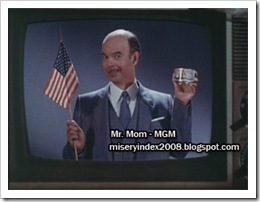 I don't know if anyone remembers the movie Mr. Mom and the Schooner Tuna commercial. The challenge was, with sales slumping, how Schooner Tuna could survive during an economic lull.
I don't know if anyone remembers the movie Mr. Mom and the Schooner Tuna commercial. The challenge was, with sales slumping, how Schooner Tuna could survive during an economic lull.
It was Carolyn Butler who turned that tuna account around, thanks to her personal experience, her insight into the market - an insight that wasn’t shared by the rest of the execs around that table.
Carolyn: Well, frankly none of this stuff would influence me, all right?
Male executive: Come on, Ron. She doesn’t know a tuna fish from a Cheerio.
Female executive: Damn good thing we don’t have the Cheerio account.
Carolyn: Well, when was the last time any of you people were in a supermarket?
From “Yum Yum Tuna Bits” to “The Tuna With a Heart”, it was she who brought the priorities of consumers - of moms like her - to that boardroom. She reminded Humphries that housewives didn’t need corporate gimmicks, but in fact needed a break on the high price of tuna. And by doing this, Schooner Tuna would win over the housewives loyalty.
My fellow Americans. I am Howard Humphrey, President of Schooner Tuna. All of us here at Schooner Tuna sympathize will all of you hit so hard by these trying economic times. In order to help you we are reducing the price of Schooner Tuna by 50 cents a can. When this crisis is over, we will go back to our regular prices. Until then, remember, we’re all in this together. Schooner Tuna. The tuna with a heart.
Of course Schooner Tuna's profits would take a hit but which is better? Taking a hit on profits, still making a profit, although smaller, versus losing money when consumers decided that your product is too expensive to buy, and stop buying your product all together.
Well, don't expect food companies today to feel the same way in this economy, as they are out to actually make $$ off your couponing, and size comparisons!
There's the incredible shrinking product, the incredible reformulation of the product, the bigger is more expensive per ounce than smaller, and a new marketing ploy ready to hit the airwaves, TV's and even PTA and church meetings.
First, there's the incredible shrinking product, yet the price remains the same.
This one is tricky. The packaging remains almost exactly the same however, it's not. "Package size reduction is mainly focused on the US, and is only one of our responses to dramatic input cost increases," Dean Mastrojohn, the US spokesman for Unilever has said. "They want to increase the price without the consumer realizing. The way to do that is with a smaller package, but when they put that package out, they don't advertise that it's smaller," Deirdre Cummings, legislative director at a consumer advocacy group called MASSPIRG has said.
Other examples than the ones below, but not limited to, are Edy's Ice Cream (1.75qt to 1.5qt), White Rain Shampoo (19.95 fl oz to 18 fl, yet both bottles say 33% more. Glad Trash bags (96 bags to 80 bags). Dial bar soap (4.5oz each bar to 4.0oz each bar). Folgers Classic Roast Coffee (3lb 4oz, makes up to 360 cups to 3lb 0oz, makes up to 380 cups, yet the directions for how much coffee vs water to use remain the same). Hellmann's mayonnaise (32oz to 30oz). Country Crock (3lb to 2lb 13oz). Breyers ice cream (56oz to 48oz). Hefty Gripper Trash Bags (40 bags to 34 bags). Pampers diapers, Size 3 (80 to 72).
Apple Jacks, Cocoa Krispies, Corn Pops, Fruit Loops and Honey Smacks were reduced by an average of 2.4oz for 14 items. "This price adjustment on select ready-to-eat cereal brands was taken to offset rising commodity costs for ingredients and energy used to manufacture and distribute these products," said Kellogg's spokeswoman Susanne Norwitz.
In the video "Food Amounts Shrink Over Years, But Containers Are Same Size", Mary Bach, a consumer advocate for the AARP, shows some shocking comparisons, and lines she has been told by product companies.
Then, there's the reformulation of a product.
Food makers have also been substituting cheaper ingredients.
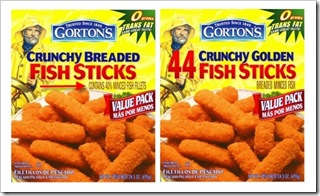 | Notice that one says "Contains 40% Minced Fish Fillets" and the other states "Breaded Minced Fish". |

| Then there's the reformulation of chocolate from "Milk Chocolate" to "Chocolate Candy". From the Candy Blog:
|
There's also the buy a smaller package, pay less per ounce. Buy a larger package, pay more per ounce deal.
Here's a most recent example that I happened across. Tidy Cat litter at Wal-Mart. A 10lb bag was $1.53 ($0.153 per pound) A 30lb bag was $6.50 ($0.217 per pound). Also recently seen at Wal-Mart were Ball Park Hot Dogs. Regular price was $2.44 for 1 pkg. Two pkgs were 2/$5.00. At Target, one SpeedStick was $1.77. Two were $3.59, an additional $0.05. When shopping, don't look at the cheapest price, or packaging that states "Save when you buy 2!". Look at the price per ounce, as opposed to packaging size. Use a calculator if needed. Many times you will find buying two smaller packages is cheaper than buying one larger package.
Now, there's a new marketing ploy.
In an article from The Wall Street Journal, food companies are hoping to sell you cheap or cheaper food, for greater profits. From TWSJ:
On Monday, Kellogg Co. is beginning a new advertising push for staple cereals such as Corn Flakes and Rice Krispies, which Campbell Soup Co. is about to launch a multimedia campaign to trumpet its condensed soups as a bargain buy. Kraft Food, Inc. has begun advertising its Kool-Aid powdered beverages on national radio for the first time in 11 years.
Campbell and cheese giant Kraft are also teaming up to promote meals of soup and grilled-cheese sandwiches. Kraft's website will add recipes for cheap sandwiches and suggest Campbell soups to pair them with.
On Nov. 2, newspapers nationwide will carry coupon inserts pitching Campbell soups and sandwiches made with Kraft Singles cheese as the "wallet-friendly meal your family will love."
It is a big shift for food makers. For several years they have tried to increase their profit margins by promoting higher-priced "premium" brands such as Campbell's Pepperidge Farm cookies and Kraft's Wheat Thins crackers.
But lower-priced "value" products can also have wide margins because they're cheaper to make. "Food companies will be careful to shift consumers to products that are still high margin," says Robert Moskow, an analyst with Credit Suisse. "Powdered Kool-Aid beverages are one of the most profitable food products in history."
Also Monday, the milk industry will begin running ads touting milk as a bargain. Financial guru Suze Orman will don the familiar milk mustache in a print ad that reads: "Even at today's prices, a glass of milk only costs about a quarter..." The ad is a big departure from prior "Got Milk" campaigns that focused on the nutritional value of milk.
The milk industry plans to spend just under $1 million on the Suze Orman ads.
ConAgra Foods Inc. is rolling out a line of single-serve frozen dinners priced at $1.50 each and embarking on a word-of-mouth campaign through PTA meetings and church groups. "So good for so little" goes the slogan planned for part of an ad campaign.
ConAgra's new Banquet dinners - called Banquet Select Recipes - will be priced 41 cents higher than the company's existing Banquet line, giving them a higher profit margin, says Joe Bybel, vice president of strategy at ConAgra. "It's good for ConAgra but also a good value for consumers."
Companies' "value" pitch is, in part, a defensive move against private-label food makers that could steal market share with their cheaper goods. But it's also a response to how consumers have changed their behavior as the U.S. economy has soured. Consumers worried about jobs, 401(k)s, gasoline prices and winter heating bills are eating less often at restaurants and making fewer supermarket trips to stock up on groceries.
Food companies themselves have contributed to the pressure on consumers by raising prices on a host of items - ranging from bread to meat to cereal - in response to rising commodity costs. Prices for food for the home rose 7.5 percent at a seasonally adjusted annualized rate in the first eight months of this year, according to the Bureau of Labor Statistics.
Some consumers are holding off trading down out of concern that lower-priced products are less nutritious. "I'm noticing the higher prices and I'm feeling it, but I want my kids to eat well, so I'm still buying organic," says Becky Jeffers, a 36-year-old yoga therapist and single mother of two who was shopping at a Lake Forest, Ill., Jewel-Osco last week....
...High food prices have driven some consumers to trade down to supermarkets' private-label products, particularly in milk, cheese and canned tomatoes. The growth of private-label market share accelerated in the 12 weeks ended Sept. 6 with private-label items in 89 of 105 categories posting gains, compared with 80 in the prior 12-week period...
Food companies continue to tout their high-end offerings, and not all plan to push cheaper goods harder. Spokesmen for ketchup makers H.J. Heinz Co. and Sara Lee Corp., maker of Jimmy Dean sausage and Ball Park hot dogs, says their brands have always stood for good value.
ConAgra, of Omaha, Neb., hasn't advertised its 55-year-old Banquet frozen dinners in more than a decade. Until now, the company's premium line of frozen dinners, Healthy Choice Cafe Steamers, which are double the price of Banquet meals, have gotten more marketing support. But the new Banquet Select Recipes, in varieties including chicken parmesan and home-style pot roast, will be supported by radio spots with country singer Lee Ann Womack.
TV ads showing a family eating dinner. When the mom tells the dad that each meal costs $1.50, he looks so shocked that she splashes him with a glass of water.
ConAgra's word-of-mouth effort will enlist hundreds of mothers to provide money-saving tips and free product samples at PTA meetings and church groups across the country. The moms will be paid in Banquet product coupons, the company said.
Kellogg will begin airing TV ads for its Frosted Mini-Wheats, Frosted Flakes, Rice Krispies and Corn Flakes brands, hailing them as affordable breakfast choices. The Battle Creek, Mich., company is also working on search-engine optimization so that when consumers type "cereal" plus "deals" or "value" into an Internet search engine, Kellogg's Web site will pop up.
In mid-October, Campbell Soup will launch TV, radio, print and Internet ads touting its condensed soups as cheap eats, a departure from last year's ads, which played up the soups' quality...
...One print ad shows a lineup of five condensed soups, including chicken noodle and minestrone, calling it the "original dollar menu." Another ad says, "To save you money, we left one ingredient out (we figured you have plenty of water at home)."
In supermarket aisles, Campbell has begun separating higher-priced, ready-to-serve soups from cheaper condensed soups. "It's important for consumers to see value in our category," says Colin Watts, vice president and general manager of Campbell's U.S. soup business.
Mr. Watts says that after Campbell noticed that consumers were making fewer grocery visits, it began offering 10 cans of condensed soup for $10 at some stores. The company's Web site offers recipes for meals that use the company's condensed soups and Swanson broths and cost less than $10 to make.
Kraft's Web site shows visitors how one bag of groceries filled with Kraft products can be stretched to make five dinners. And a 15-second TV commercial for Kool-Aid shows that four pitchers of Kool-Aid cost the same as a two-liter bottle of soda. At the end, a voice-over says, "Kool-Aid: delivering more smiles per gallon."
What they don't seem to focus on, is the fat and sodium content of these prepared meals and soups. Take a look at Banquet Dinner and see how much of the "Recommended Daily Allowance" of sodium you get in that $1.50 meal. And its a (insert sarcasm here) wonderful thing of how these products don't have much actual or nutritional food ingredients in them. You're better off eating a peanut butter and jelly sandwich with yogurt and fruit, or a bowl of cereal. But I guess a bowl of tomato soup, grilled cheese and Kool-Aid is what's on the menu for dinner!

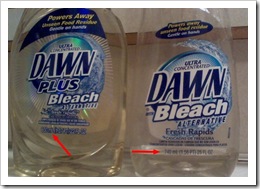
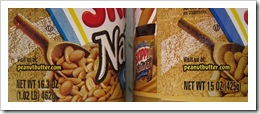
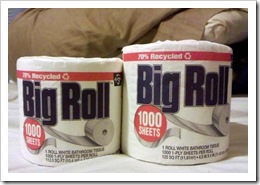

2 Responses to "Schooner Tuna, where are you when we need you?"
Post a Comment